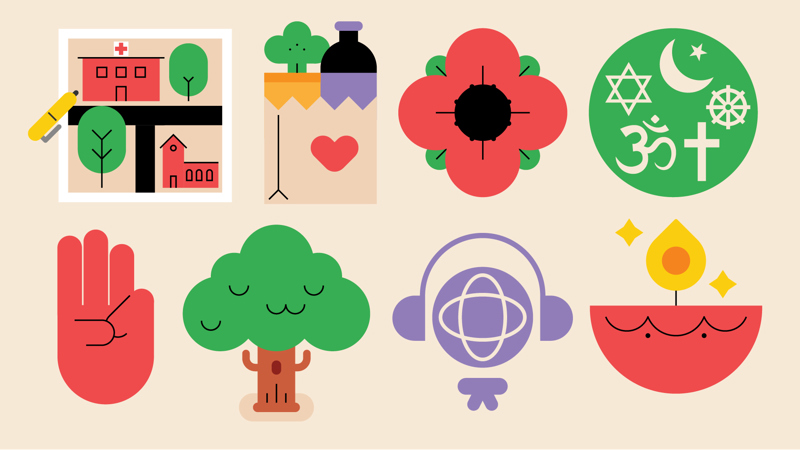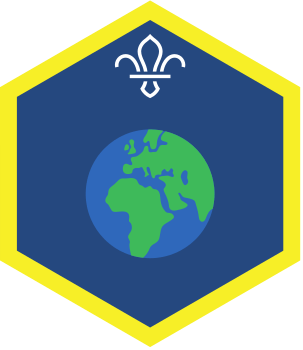
Part of the family
You’ll need
- Scrap paper
- Pens or pencils
A Scout’s Own is an inspirational, informal ceremony that often lasts no longer than 15 minutes. They’re made up of a mixture of readings, reflections and music.
This is just one example of how to have a Scout’s Own. There are lots of different themes, topics, and activities to choose from – when you’re planning a Scout’s Own think about including elements such as an opening, reading, activity, music, and closing. We’ve included some more information on these (and some other things to consider) to help.
Opening
1. The person leading the ceremony should explain that different types of families have different names, for example, a family of Beavers is called a Colony, while a family of wolves (or Cub Scouts!) is called a Pack.
2. The person leading the game should explain that we’re all part of different families, too. Sometimes a family is made up of people who share a name, or blood, but sometimes families are made up of people who share something else, like an interest or a religion.
3. Everyone should close their eyes and think about who they’d consider part of their family. What does family mean to them? The person leading the ceremony should give everyone a few moments to think before they move on.
Reading
1. The person leading the ceremony should remind everyone that the name called Cub Scouts comes from the wolf pack in The Jungle Book, a book by Rudyard Kipling.
2. Someone should read this poem, called The Law of the Jungle. It’s taken The Second Jungle Book by Rudyard Kipling.
‘Now this is the Law of the Jungle, as old and as true as the sky;
and the Wolf that shall keep it may prosper, but the Wolf that shall break it must die.
As the creeper that girdles the tree-trunk, the Law runneth forward and back;
for the strength of the Pack is the Wolf, and the strength of the Wolf is the Pack.’
3. Everyone should talk about the poem – it uses some quite old fashioned words, so are there any that people don’t understand? To ‘prosper’ means to be successful (or grow strong and healthy), while ‘girdle’ means to go around. ‘Runneth’ is just another way to say ‘runs’.
4. Everyone should think about what the law means. What does it say about how a group works? Is it true for all groups and families? How does it make everyone feel?
Activity
This activity lets everyone draw a Scouts family circle that starts with them and ripples outwards. We’ve included an example image, to help you explain.
1. Everyone should draw a small circle in the middle of a piece of paper. They should draw a slightly bigger circle around it, and repeat until they have seven circles, all inside one another.
2. Everyone should write their own name and the names of everyone else in their Six in the middle circle.
3. Everyone should write the name of their Cub Pack in the next circle outwards.
4. In the next circle, everyone should write the name of their Scout Group.
5. In the next circle, everyone should write their Scout District, and then in the next their Scout County. The person leading the activity might need to help people remember if they’re unsure.
6. Everyone should write the name of their country in the next circle.
7. In the final circle, everyone should write the world. This reminds everyone that they’re part of the World Organization of the Scout Movement (WOSM) – when people join a section and make their Promise, they become a member of this global family. This means that Scouts all over the world are part of one family; we all share values and try to do our best as individuals and as a movement.
8. The person leading the activity should ask if anyone knows how many Scouts there are in the world. WOSM estimates that there are around 40 million!
Music
1. The person leading the game should play ‘That’s What Friends Are For (The Vulture Song)’, from Walt Disney’s The Jungle Book.
2. While the song is playing, everyone should reflect on their place in the Scout family. They might want to think about times they’ve been supported, or times they’ve supported others.
Closing thought to take away
1. Someone should read out what Akela said about Mowgli to the wolf pack:
‘He is our brother in all but blood’.
2. Everyone should check that they understand what this means – Akela is telling the other wolves that it doesn’t matter that Mowgli isn’t a wolf (or that he isn’t related to them), he’s still part of the back and their brother.
3. Everyone should think about the different families they belong to, including any made up of people who share interests and beliefs.
4. Everyone should think about the best bits of being part of these networks. For example, they can help us feel happy and valued, and people can help us when things get tricky. What can people do to welcome others into their families?
Reflection
A Scout’s Own is a great chance to build friendships. Did the Scout’s Own help you feel closer to your friends? Did you hear from people you don’t normally speak to? Did the Scout’s Own help you think about your friend, or a topic like what makes a good friend?
A Scout’s Own also needs you to respect others. How did you show respect for people who were reading things or sharing ideas? What did you do if you disagreed with someone’s idea? Does spending time thinking together help us learn to trust? Can you still respect and trust people who have different ideas to you?
Safety
All activities must be safely managed. You must complete a thorough risk assessment and take appropriate steps to reduce risk. Use the safety checklist to help you plan and risk assess your activity. Always get approval for the activity, and have suitable supervision and an InTouch process.
Remember that different families look and feel different – there’s no one way to be a family.
Some people might find the idea or topic of family difficult or upsetting. If anyone will find this difficult, choose another theme, or focus on ‘groups’ without using the word family (or examples that are about families).
A Scouts' Own doesn’t have to fit any certain framework – it’s up to you how you use the suggested elements to work for your group.
Some people might find it harder to sit still and quietly and listen – why not think about a quiet activity they can do at the same time as listening?
All Scout activities should be inclusive and accessible.
The best Scout’s Owns are the ones that are designed and led by young people. Help people to come up with and deliver different parts of the Scout’s Own, or even the whole thing.
